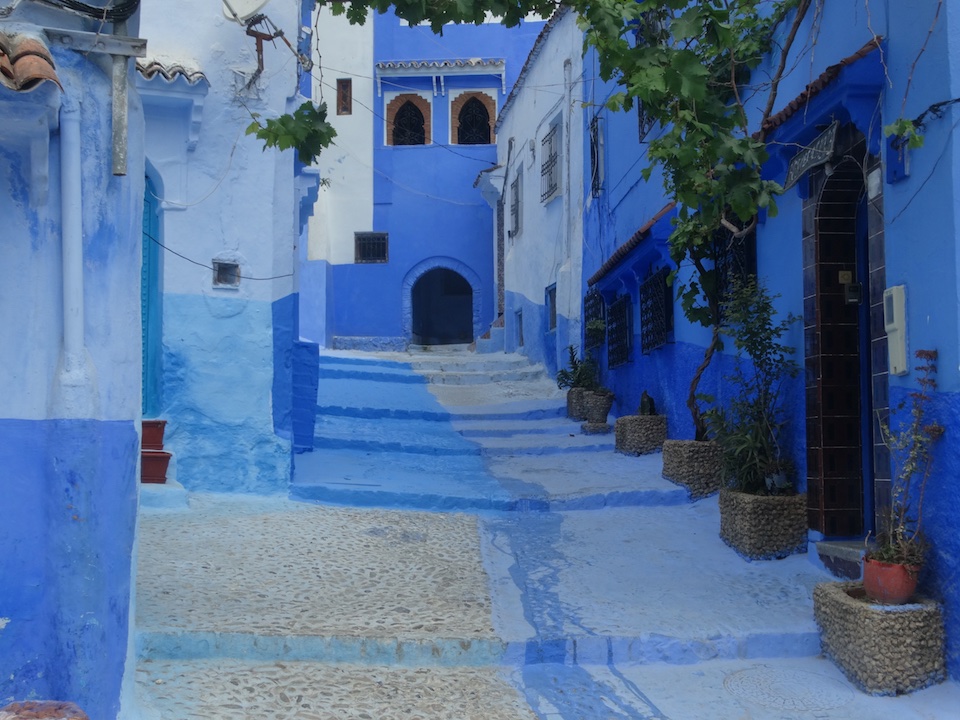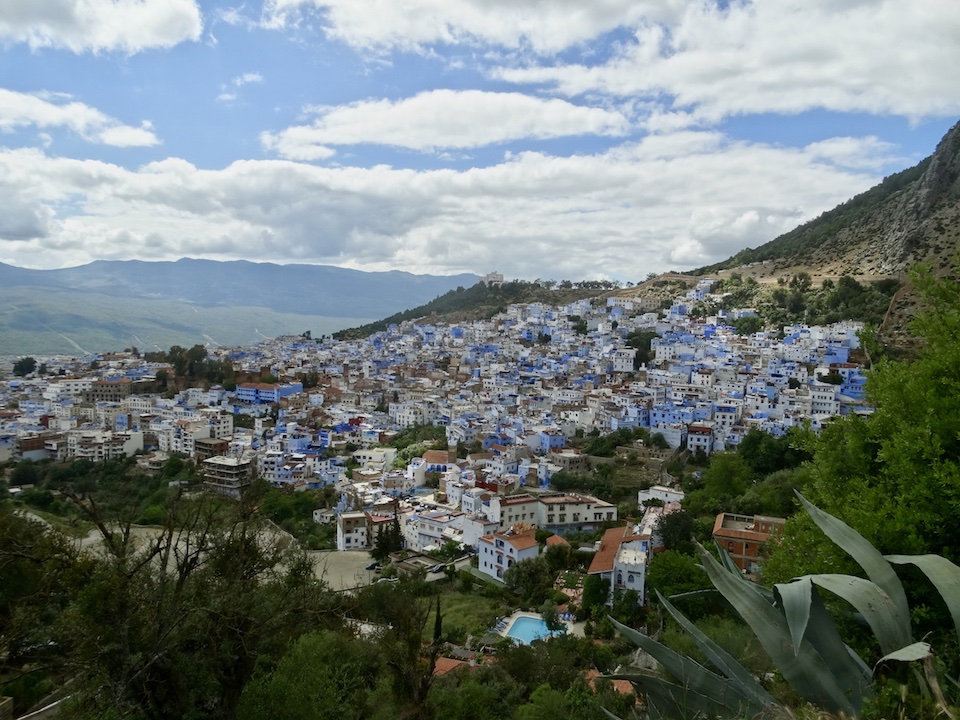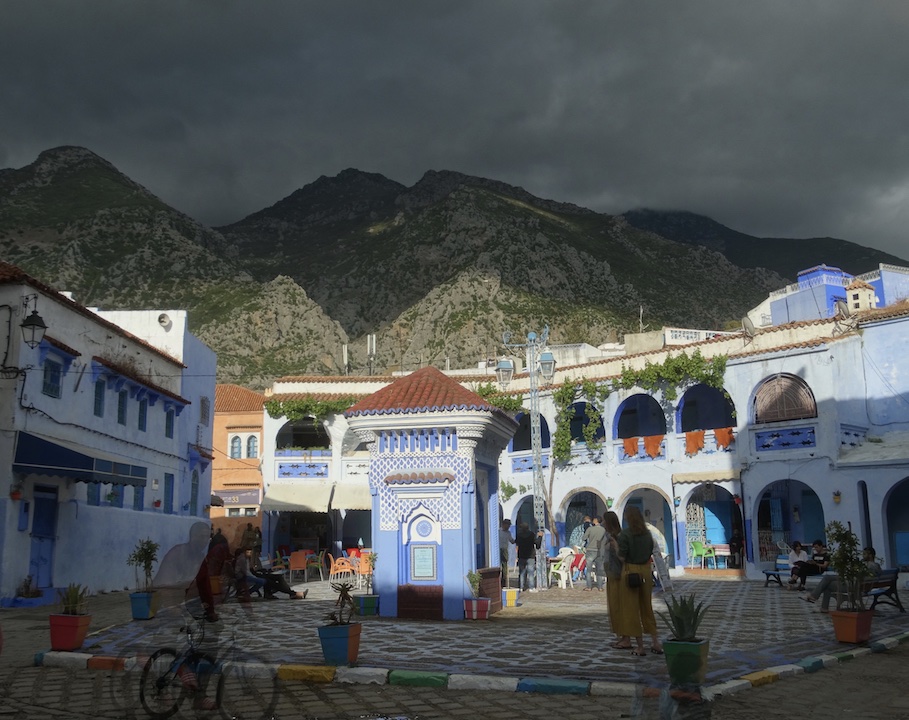THE HIGHS AND LOWS OF KIF

Early on in my time in Casablanca, I had heard about the “Blue City”. It was lauded as one of Morocco’s most interesting destinations. Depending on who you talked to, this was either due to its colourfully painted houses or the profusion of “kif” that was readily available to buy and smoke. Chefchaouen, to use its official name, is a village nestled in the green hills of the Rif mountains in northern Morocco. Green has particular significance here. Reason being, in addition to cork oak, Moroccan fir and Allepo pine, a thick pelt of the cannabis plant covers many of the hillsides.
The Blue City
Nevertheless, arriving in Chefchaouen, the azure, ultramarine, maya and other shades in its broad blue palette leap off the canvas. There are various theories behind the daubed walls, houses and steps. Some maintain that it is the early Jewish residents that wished to honour the skies, heaven and divinity through the blue paint. Others believe that it reflects the region’s Mediterranean identity and the glistening blue coastline further east. However, I saw an old photo of Chefchaouen in a museum in Marrakech which depicted white not blue buildings in the early part of the 20th century. Being a sceptic, this makes me think that canny locals have leveraged the blue paint as a tool to drive tourism to the region. There is also a chance that the photo in the museum was black and white though.
The Kings of Cannabis
There is, though, a second magnetic force pulling people from all over the world to this hillside village. It is the abundant hashish. That, coupled with lax enforcement of the strict laws on drug and alcohol consumption that exist elsewhere in Morocco. You could be forgiven for thinking that this is to create a unique environment where exemptions to traditional norms and laws exist for the benefit of the thriving tourism industry. After all, bars, clubs and bikini’s are tolerated in many parts of the Islamic world, albeit with certain conditions.

The situation in the Rif is far more complex though. Morocco is the world’s largest producer of cannabis and by some estimates supplies 70% of what its European neighbours to the north consume. Morocco has long been a haven on the smoking circuit. Indeed, the Rolling Stones became ambassadors for the country’s illicit charms as early as the 1960’s. In spite of their involvement, people continue to flock to the country, where getting high is, well, a high priority.
The Hidden Costs of Kif
The cannabis that is grown, cultivated and then compressed into resin is conveniently known as kif in the Rif. What’s more, the word ‘reefer’ (the combination of kif and tobacco rolled in cigarette papers) is thought to originate from the name of the area. A pattern starts to emerge. The travellers that descend on Chefchaoen looking for kif do so under the impression that buying and smoking the local produce is as benign as the drug itself. At least compared to harder intoxicants like cocaine, heroin or mint tea with 6 cubes of sugar. Perhaps some also believe that it boosts the local economy along with taxi fairs, hostel bunks and cous cous dinners.
But, much like any other drug trade, they are unwittingly sustaining organised crime networks and burdening tax payers. We all have to foot the bill for police forces in Morocco, Spain and beyond to pursue their decades long, and ultimately futile, war on drugs. A trade that supplies customers from the hostels of Chefchaouen to the cafes of Amsterdam.
The Rif is replete with beautiful scenery and traditional customs. But grinding poverty and inarable land make growing cannabis one of the few viable incomes available to many of the rural communities. Cannabis farming supports up to a million people by some estimates. Impoverished farmers, growing crops that go on to generate huge sums for the middle men, vendors and investors is a centuries old narrative. It features in stories where everything from sugar to coffee and cocoa leaves are the commodity.
The Rif farmers live in a cycle of fear and bribe payments to government officials in order to avoid arrest and prison. Communities then become increasingly marginalised as they circumvent administrative practices like registering births or renewing ID for fear of the charges that hang over them coming to light and leading to prosecution. Consequently, they become outlaws. This leads to being denied access to hospital treatment, education and other basic rights afforded to their countrymen.

Blissful Ignorance
Meanwhile, on the roof terraces of hostels in Chefchaouen, travellers puff away. They are oblivious to the industry that they are supporting and the impact on the local population. Having said that, travellers are oblivious to a lot of things that result from their investment and activities. Perhaps blissful ignorance is part of the enjoyment of being overseas. Certainly, the hostel that I stayed in had an established, if chaotic, system for supplying guests with accommodation and kif.
The proprietors were a local father and son team who ran the reception and dealt with bookings and payments. A volunteer from Australia took care of selling kif on the roof terrace and assisting the proprietors with administrative tasks. The gaunt, dread-locked Aussie, smoked kif from morning til night and his ability to converse coherently suffered as a result. The burly but affable son was more articulate, but faced two unenviable tasks. One, trying to ensure that the Aussie completed his tasks – which unsurprisingly conflicted with his responsibilities as in-house kif vendor. Two, appeasing his weary father and keeping the hostel clean. It was an odd and slightly dysfunctional set-up, but the backpackers kept coming.
The Blue City was without doubt worth visiting. I took numerous photos of the cavernous blue streets, like so many before me. My stay there coincided with Ramadan, which can be a challenging time to travel in Muslim countries. However, the sunset views from the hills above the village and the haunting evening call to prayer made for a great experience. It was only months after leaving Morocco that I started to take more of an interest in the kif industry. Its numerous contradictions and quandaries lying dormant. Ultimately, I’m no closer to arriving at my ethical position on kif. I also still have no idea why they paint Chefchaouen blue; but I’m fine with that.